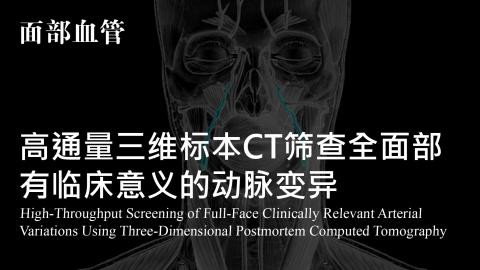
- 2980人
- 分享收藏
【面部血管文献】高通量三维标本CT筛查全面部有临床意义的动脉变异
High-Throughput Screening of Arterial Variations
简介
【 文献重点摘要 】
Background
Vascular complications resulting from intravascular filler injection and embolism are major safety concerns for facial filler injection. It is essential to systematically screen full-face arterial variations and help design evidence-based safe filler injection protocols.
Methods
The carotid arteries of 22 cadaveric heads were infused with adequate lead oxide contrast. The facial and superficial temporal arteries of another 12 cadaveric heads were injected with the contrast in a sequential order. A computed tomographic scan was acquired after each contrast injection, and each three-dimensional computed tomographic scan was reconstructed using validated algorithms.
Results
Three-dimensional computed tomography clearly demonstrated the course, relative depth, and anastomosis of all major arteries in 63 qualified hemifaces. The ophthalmic angiosome consistently deploys two distinctive layers of branch arteries to the forehead. The superficial temporal and superior palpebral arteries run along the preauricular and superior palpebral creases, respectively. The study found that 74.6 percent of the hemifaces had nasolabial trunks coursing along the nasolabial crease, and that 50.8 percent of the hemifaces had infraorbital trunks that ran through the infraorbital region. Fifty percent of the angular arteries were the direct anastomotic channels between the facial and ophthalmic angiosomes, and 29.2 percent of the angular arteries were members of the ophthalmic angiosomes.
Conclusions
Full-face arterial variations were mapped using postmortem three-dimensional computed tomography. Facial creases were in general correlated with underlying deep arteries. Facial and angular artery variations were identified at high resolution, and reclassified into clinically relevant types to guide medical practice.
背景
面部填充物注射引起的血管并发症和栓塞是面部填充物注射的主要安全问题。系统地筛查面部动脉变异并帮助设计循证安全的填充物注射方案是至关重要的。
方法
对22例身体头颅的颈动脉进行充分的氧化铅造影剂灌注。对另外12具身体头颅的面动脉和颞浅动脉按顺序注射造影剂。在每次对比剂注射后采集计算机断层扫描,并使用有效的算法重建每个三维计算机断层扫描。
结果
三维CT清晰显示63个符合条件的偏侧各主要动脉的走行、相对深度和吻合情况。眼部的血管体在前额持续地展开两层不同的分支动脉。颞浅动脉和睑上动脉分别沿耳前和睑上皱褶走行。研究发现,74.6%的半面有鼻唇干沿着鼻唇折痕移动,50.8%的半面有眶下干穿过眶下区域。50%的角动脉是面、眼部血管体之间的直接吻合通道,29.2%的角动脉是眼部血管体的成员。
结论
使用尸检三维计算机断层扫描可绘制面部动脉变异图。面部皱纹一般与深层动脉相关。面动脉和角动脉变异以高分辨率识别,并重新分类为临床相关类型,以指导医疗实践。



